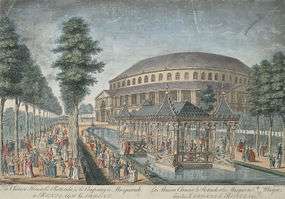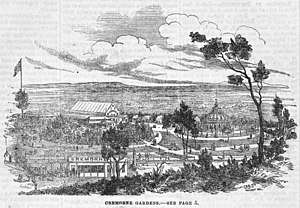Pleasure garden
A pleasure garden is usually a garden that is open to the public for recreation and entertainment. Pleasure gardens differ from other public gardens by serving as venues for entertainment, variously featuring such attractions as concert halls, bandstands, amusement rides, zoos, and menageries.


History
Public pleasure gardens have existed for many centuries. In Ancient Rome, the landscaped Gardens of Sallust (Horti Sallustiani) were developed as a private garden by the historian Sallust. The gardens were acquired by the Roman Emperor Tiberius for public use. Containing many pavilions, a temple to Venus, and monumental sculptures, the gardens were open to the public for centuries.
Many public pleasure gardens were opened in London in the 18th and 19th centuries, including Cremorne Gardens, Cuper's Gardens, Marylebone Gardens, Ranelagh Gardens, Royal Surrey Gardens and Vauxhall Gardens. Many contained large concert halls, or hosted promenade concerts; some lesser discussed pleasure gardens were home to haberdasheries and harems. A smaller version of a pleasure garden is a tea garden, where visitors may drink tea and stroll.
The pleasure garden also forms one of the six parts of the 18th century "perfect garden" , the others being the kitchen garden, an orchard, a park, an orangery or greenhouse, and a menagerie.
See also
References
Further reading
- Melanie Doderer-Winkler, "Magnificent Entertainments: Temporary Architecture for Georgian Festivals" (London and New Haven, Yale University Press for The Paul Mellon Centre for Studies in British Art, December 2013). ISBN 0300186428 and ISBN 978-0300186420.
- Wroth, A. E. & W. W. The London Pleasure Gardens of the Eighteenth Century (MacMIllan, 1896).
External links

